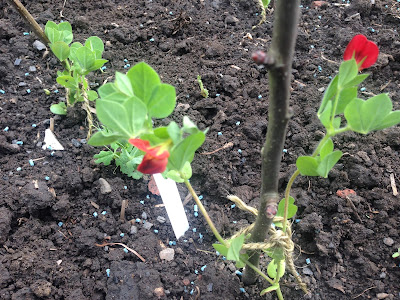Elizabeth David has a lot more to say with recipes for Terrine de Campagne, duck, veal, hare, pigeon and rabbit terrines. She employs two methods, the first is to pack a terrine tin with all your ingredients, then cover with aspic, a jellied stock made from pigs trotters, then cook. Or, the method I use, to line your terrine tin with bacon, layer in your terrine ingredients, seal with bacon, then cook and press overnight.
I am not au fait with an aspic yet, and Elizabeth says that they keep better using the bacon method anyway. A terrine was a preservation method originally. The terrine itself keeps very well for about a week, and improves in flavour after a few days. But if you seal it into the tin after cooking and cooling, with a layer of pig fat, it can keep for up to a month.
Most of the recipes that ED uses have similar flavours, juniper, thyme, brandy, some sort of liver, lemon zest, bay, mace and garlic appear in most instances. In spring and summer i would use fresher flavours, perhaps a poached chicken with lemon zest, thyme and almonds, then in autumn and winter I prefer game; duck or pigeon, with juniper, brandy and rich chicken livers.
I'll tell you my method, it is easily changeable depending on the season and what is to hand. Once you have made a couple you can switch things around and experiment, I don't think you can go that wrong once you have mastered the basics.
For a duck terrine I use two small wild duck, for pigeon you would probably need 4 birds and you can see the chicken method here... Roast the duck at 200˚C for 15 minutes. They don't need to be entirely cooked as you are going to cook the terrine again, very pink is fine as you want it to stay moist, a dry terrine isn't good.
Leave the birds to cool and when you can handle them cut off the breasts and legs and shred every scrap of meat you can get off them into bite size pieces, this is best done by hand. Keep the carcasses to make stock if you wish, it's lovely for a Cassoulet.
Now you can freestyle, but I'll tell you what I add. 2 tablespoons of brandy, a clove of grated garlic, 5 juniper berries crushed and finely chopped, the leaves from a large sprig of thyme, half a teaspoon of mace and a large handful of chicken livers cut into bite size pieces. I used to mince it finely, but now I prefer to come across these rich creamy pieces while eating the terrine. Then a handful of pistachios, I like the added texture of a nut, and a little pop of bright green when you cut it open.
Then I grease the terrine tin with butter and place three bay leaves on the base. These look pretty when you turn it out, but they also add flavour as the terrine steams in the oven. Line the tin with unsmoked streaky bacon, about 600g. The whole thing needs to be wrapped in the bacon, so line the bottom and the sides, leaving longer pieces so you can wrap over and also seal up the top.
Then you are going to layer up the sausage meat mix and the duck, starting with a layer of sausage meat, you will have three layers of this, with two layers of duck in between, starting and ending on sausage meat. So add a third of your sausage meat mix to the bottom of the tin and flatten it down with your hands into a pressed layer. Then add a layer of the duck meat, half of it in total, spread it out evenly over the sausage meat and again press it down, then the next third of sausage meat, then the remaining duck, then the final layer of sausage meat, pressing down the layers in between. When it is all in, then fold over the bacon sealing up the top, add a few extra bits here and there if you have any gaps.
Now it is ready to cook. Cover with a piece of greaseproof paper slightly larger than the tin, and tie this up with a piece of string. Place the terrine into a large deep baking tray and fill with water about half way up the side of the terrine tin. You are aiming to slowly cook/steam the terrine, so don't add boiling water, I usually add something tepid as freezing cold slows everything down too much. Then put into the oven for about an hour at 150˚C, until the terrine has come away from the edges of the tin If you want to measure it with a probe, the internal temperature should be about 68˚C. Remove from the oven and pour out the water.
Then leave it to sit over night weighted down. I find it best to then leave it in its tin for a further day in the fridge for the flavours to really come out. Then slice and eat. It is good with hot toast, chutney or pickle. I made some pickled damsons which were lovely with the game, a spiced apple chutney is good, or a sweet pickled cucumber, or just a few little cornichon. It's a good thing to have around over Christmas if you can find the time to make it in advance as it can just sit in the fridge if you need a snack or guests arrive for lunch... It has a lovely rich flavour, spiced, moist duck, creamy chicken livers... delicious.
























































